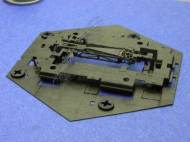Pop-up books inspire new fabrication method for small and complex devices
 Engineers at Harvard University developed a new technique inspired by pop-up books which enables rapid fabrication of a broad range of electromechanical devices through layering and folding process. The method is also useful for parallel fabrication of Monolithic Bee (also known as “Mobee”) microrobots which rely on PARITy drivetrain we described in one of our articles.
Engineers at Harvard University developed a new technique inspired by pop-up books which enables rapid fabrication of a broad range of electromechanical devices through layering and folding process. The method is also useful for parallel fabrication of Monolithic Bee (also known as “Mobee”) microrobots which rely on PARITy drivetrain we described in one of our articles.
The technique development was led by Pratheev Sreetharan and J. Peter Whitney Whitney, both doctoral candidates at the Harvard School of Engineering and Applied Sciences (SEAS).
“Our new techniques allow us to use any material including polymers, metals, ceramics, and composites”, said principal investigator Rob Wood, an Associate Professor of Electrical Engineering at SEAS and a Core Faculty Member at the Wyss Institute for Biologically Inspired Engineering at Harvard. “The ability to incorporate any type and number of material layers, along with integrated electronics, means that we can generate full systems in any three-dimensional shape. We’ve also demonstrated that we can create self-assembling devices by including pre-stressed materials.”
Instead using a painstaking and error-prone method to fold, align, and secure each of the minuscule parts and joints of the microrobots, the new method relies on locking mechanisms and dip soldering. The material used to build prototypes consists out of 18 layers of carbon fiber, Kapton (a plastic film), titanium, brass, ceramic, and adhesive sheets that are laminated together in a complex, laser-cut design which can be assembled in one movement.
“The alignment is now better than we can currently measure”, said Sreetharan. “I’ve verified it to better than 5 microns everywhere, and we’ve gone from a 15% yield to – well, I don’t think I’ve ever had a failure.”
Designing how all of the layers will fit together and fold isn’t automated and it relies on standard computer-aided design (CAD) tools. However, fabrication can be fully automated once the design is complete. The fabrication itself doesn’t require special machines since it relies on the manufacturing process currently used to make printed circuit boards. The use of such machinery allows natural integration of electrical components during the fabrication process.
Aside increasing the speed of production and quality of assembly, the process lowers the overall weight of these tiny robots to only 90 mg. In comparison, the weight of the Mobee microrobot is 63rd part the weight of one U.S. quarter coin. The same mass-production technique could be used for high-power switching, optical systems, and other compact integrated electromechanical devices.
For more information, you can read the article published in IOPscience: “Pop-up book MEMS”.









Leave your response!